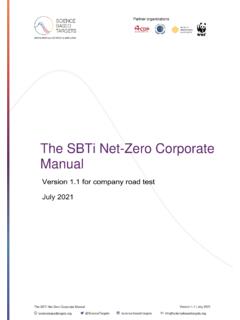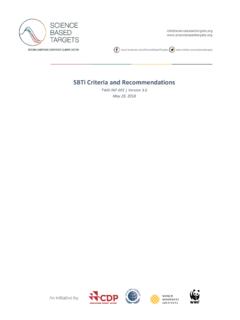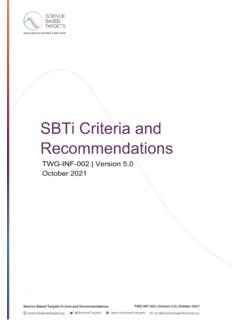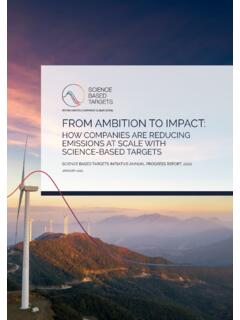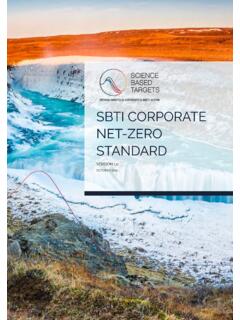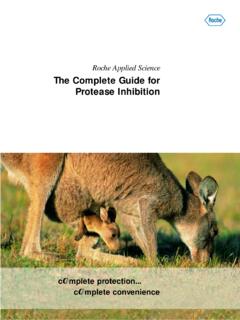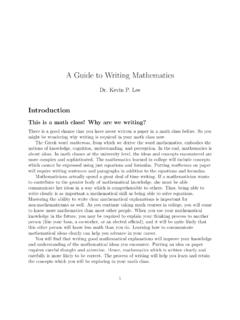Transcription of HOW-TO GUIDE FOR SETTING NEAR-TERM TARGETS
1 Science Based TARGETS HOW-TO GUIDE for SETTING NEAR-TERM TARGETS TVT-INF-001 | Version | December 2021 @ScienceTargets /science-based- TARGETS HOW-TO GUIDE FOR SETTING NEAR-TERM TARGETS SCIENCE BASED TARGETS DRIVING AMBITIOUS CORPORATE CLIMATE ACTION GETTING STARTED WITH SCIENCE-BASED TARGETS ,---NGO, cities, lnstitutio,n-,.-- i The SBTi does not currently assess TARGETS for cities, local governments, public sector institutions (above 500 Company or state-owned enterprise The SBTi Guidance for Financial Institutions outlines in detail the targetsetting requirements for SETTING both scope 1 +2 and scope 3 TARGETS for financed emissions.)
2 Employees), educational institutions or non-profit organizations. However, we encourage these stakeholders to consider science-based target SETTING methods detailed in the SBTi Corporate Manual. Cities can register their interest insetting TARGETS through the Science Based TARGETS Network (SBTN). Are you a parent company or a subsidiary? Subsidia,n11------,-----Yes:-----Parent Company Are you in the Oil & Gas sector? No The SBTi recommends that companies submit TARGETS only at the parent-or group-level, but not at the subsidiary level.
3 Parent companies must include the emissions of all subsidiaries in their target submission, in accordance with boundary criteria detailed in the SBT Criteria and Recommendations. See the Target Validation Protocol for more in the Oil & Gas sector must wait for sector-specific guidance in order to submit TARGETS for validation. See the SBTi Oil & Gas webpage for thelastest information. How many employees are in your organization? Fewer than 500 employees-----,More than 500 employees Do not have full GHG inventory/screening Do you have a full GHG emissions screening/inventory across scope 1, 2 and 3 emissions?
4 A company-wide scope 1 and 2 emissions inventory must be completed as defined by the GHG Protocol Corporate Standard and the GHG Protocol Scope 2 Guidance. Companies must complete ascope 3 inventory covering gross scope 3 emissions for all its emissions sources as set out as the minimum boundary of each scope 3 category per the GHG Protocol Corporate Value Chain (Scope 3) Accounting and Reporting may use the GHG Protocol Scope 3 Guidance, Scope 3 Evaluator, and CDP Supply Chain Program as resources. A company can commit to SETTING an SBT in parallel to performinga full scope 1, 2 and 3 GHG inventory.
5 Yes Model TARGETS using the SBTi Tool in accordance with the SBTi criteria and submit TARGETS for validation to the SBTi using the Tar et Submission Form Avoide Emissio d ns Bioenerg y-. Optional scope3 emissions ___,. n Exclusio of relevan scope3 activitie t_. s The SBTi defines a non-subsidiary, independent company and public sector institution with fewer than 500 employess as a Small and Medium-Sized Enterprise (SMEs). SMEs must submit their TARGETS through the dedicated route for SM Es using the Target SETTING Letter and will be automaticallyapproved and posted to the SBTi website, pending due diligence review and payment.
6 See our SME FAQs for moredetails. Carbon credits/ offsets must be excluded from inventory and do not count toward SBTs Avoided emissions must be excluded from inventory and do not count toward SBTs Direct CO2 emissions from bioenergy must be reported separately from inventory. See the Target Submission Form and the Target Validation Protocol for details. Optional scope 3 emissions must be reported separately from emissions in the minimum boundary of each scope 3 category in the Target Submission Form. See Table 5-4 (page 35) of the Corporate Value Chain (Scope 3) Accounting and Reporting Standard for a definition of optional emissions for each scope 3 category.
7 All relevant scope 3 sources must be calculated before submitting TARGETS to the SBTi. See Table (page 61) of the Corporate Value Chain (Scope 3) Accounting and Reporting Standard for criteria to identify relevant scope 3 activities. Science Based TARGETS HOW-TO GUIDE for SETTING NEAR-TERM TARGETS TVT-INF-001 I Version I December 2021 I@ 'JI @ScienceTargets ml /science-based- TARGETS 181 SCIENCE BASED TARGETS DRIVING AMBITIOUS CORPORATE CLIMATE ACTION SETTING SCIENCE BASED TARGETS What temperature goal should your company align its scope 1 & 2 TARGETS to and what is the target time frame?
8 What type scope 1and 2 target do you wish to set? Is a scope 3 target required? Is sector specific guidance available for your company? For more details see: C aligned Scope 1 2 TARGETS to be achieved in 5-10 years 1. 2. 3, 4, 5, 6. 7, Foundations of SBT SETTING SBTi Corporate Manual SBTi Criteria Target Validation Protocol SBTiTool Sectoral Decarbonization Approach (SDA) Sector specific guidance Scope 1 2 In of the SBTi criteria, companies must set C aligned scope 1 & 2 TARGETS using the Absolute Contraction approach or available c aligned SDA pathways.
9 Scope 1 & 2 TARGETS must cover a minimum of 5 years and a maximum of 10 years from the date the target is submitted to the SBTi for validation. Scope 1 Renewable Electricity Scope 1 and 2 must meet Absolute Scope 1 must meet Absolute Contraction or SDA minimum Contraction or SDA minimum ambition ambition requirements. requirements. Scope 2 TARGETS must meet RE sourcing requirements consistent with C scenarios. t Companies may exclude up to 5% of scope 1 and scope 2 emissions combined in the boundary of the inventory and target.
10 Scope 3 Less than 40% of overall emissions Scope 3 40% or more of overall emissions No scope 3 target required, although encouraged as best practice. Absolute Supplier/Customer CombinationEngagement If in Power or Transport sector, see sector specific guidance Companies must set one or more emission reduction TARGETS and/or supplier or customer engagement TARGETS that collectively cover(s) at least 67% of total scope 3 emissions in conformance with the GHG Protocol Corporate Value Chain (Scope 3) Accounting and Reporting Standard.
